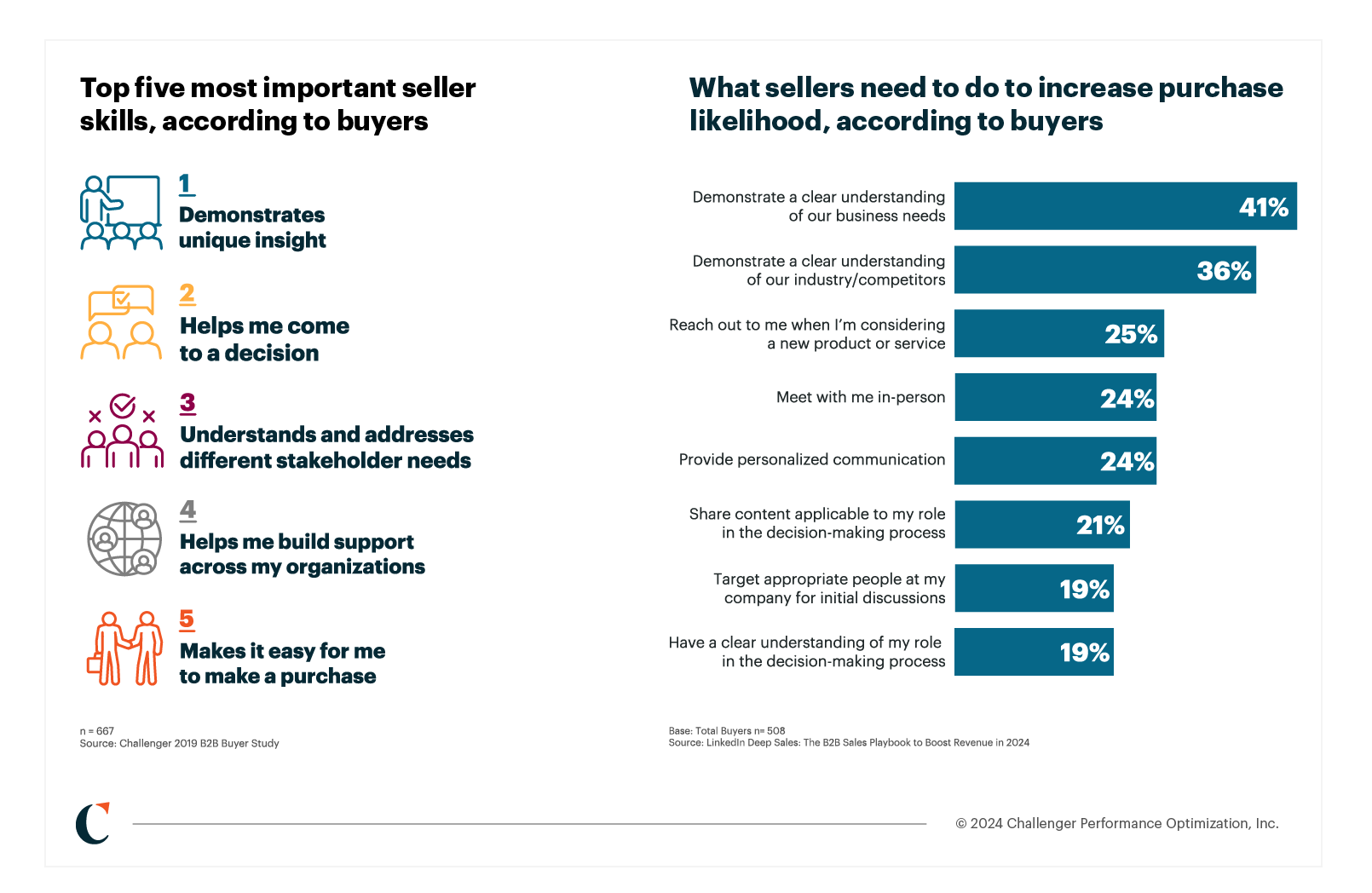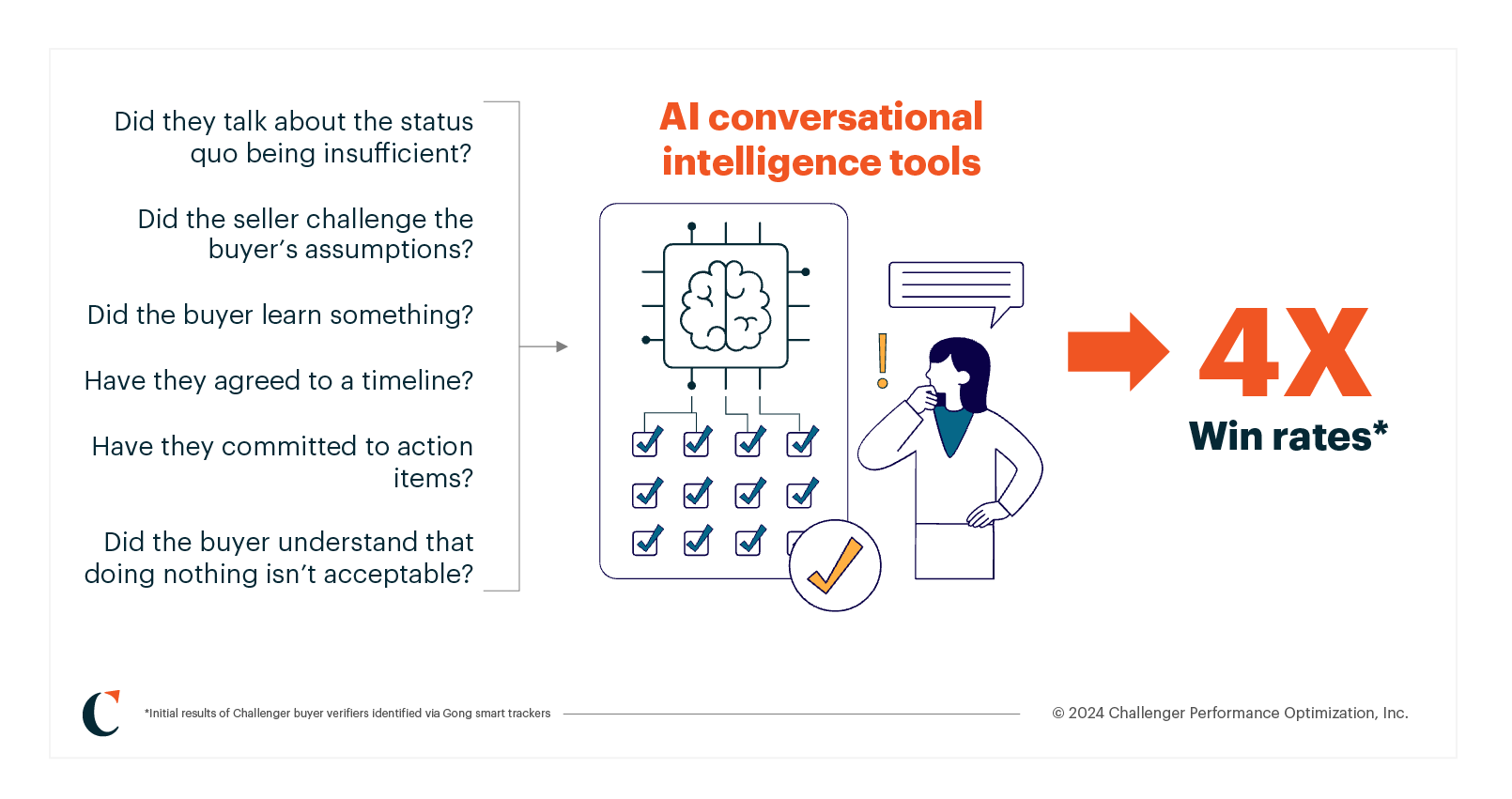ChatGPT’s explosive debut in late 2022 changed the way many of us saw artificial intelligence’s role in everyday life. Sure, industries such as aerospace, med tech, and banking had long relied on AI tools to simplify workflows, improve accuracy, and more. But for companies without extensive capital and tech, the sudden accessibility of generative AI, which uses large language models to engage in conversations and automate tasks, meant leaders faced new questions about how they should use AI. In a 2023 Hubspot report, 68% of business leaders said AI tools are already important to their overall business strategy.1
While two-thirds of them might report that AI is “important,” the truth is that sales leaders struggle to fit the growing capabilities of these tools into a well-rounded strategy to grow pipeline and closed-won deals. With so many iterations and use cases — not to mention an uptick in marketing around AI capabilities — choosing the most impactful solution is nearly impossible.
The easy answer is that AI tools can automate routine tasks. Hubspot found that AI and automation tools save sales teams more than two hours per day by scheduling meetings, taking notes, generating outreach, and entering CRM data. Among the 303 business leaders included in the report, 71% report a boost in productivity thanks to these tools.
It’s also clear that sales leaders are still determining where AI fits in their strategies. In its most recent buyer behavior survey, B2B software review site G2 found 81% of buyers think it’s important that the tools they purchase includes some kind of AI integration.2 This implies a features-and-benefits mentality to AI, rather than one focused on strategy and impact. The “spray and pray” approach doesn’t work in sales, so why do sales leaders expect to reap the most from AI capabilities by sprinkling in a bit here and a bit there?
There’s another risk inherent in this approach: that sales teams will become so caught up in efficiency that they overlook the strategic advantages of AI. In its Deep Sales Playbook survey of more than 1,500 sellers, LinkedIn found that only 31% used AI to identify at-risk deals. Only 26% used it to prioritize leads, and only 24% used it to forecast. For context, 38% used it to “create efficiencies in their sales process.” Sales leaders are less comfortable using AI for higher-level strategic purposes such as improving forecast accuracy and identifying at-risk deals, preferring to play in lower-stakes areas like time savings and productivity. By doing so, they’re leaving money on the table.
The promise of AI for sales leaders goes far beyond time savings, email generation, or creating that perfect graphic for your social selling efforts. Organizations focused on sustainable, predictable growth must choose to tap into AI’s most promising capabilities by thoughtfully selecting tools that fit their strategic priorities. The smartest revenue leaders know they need to build a sales strategy that leverages AI and machine learning to reinforce successful sales methodologies to win more and win more often. These tools don’t just save time; they increase revenue intelligence to help sellers ensure that every second of the time they do spend goes to the right place.
Tapping Into AI’s True Power
To understand AI’s real promise for revenue leaders, let’s start with their priorities.
Top priorities:
- Improving pipeline generation and performance
- Improving customer retention
- Delivering on new growth initiatives
- Increasing sales rep productivity
- Aligning GTM teams
Top Initiatives:
- Reducing the time spent on administrative tasks
- Improving revenue data quality and completeness
- Upleveling the team’s skills and competencies
- Enhancing executive visibility into GTM activities and data
- Exploring AI to enhance current revenue tech stacks
Yet together, those priorities and initiatives suggest a clear path forward for proactive sales leaders: Focusing on AI that supports greater revenue intelligence.
So how does a proactive sales leader do that?
- Begin by leveraging AI to improve forecast accuracy, lead scoring, and pipeline analysis — automate the tasks with the most room for human error and the largest direct impact on pipeline (improving pipeline generation and performance and aligning GTM teams).
- Support opportunity qualification and prioritization so sellers can make the most of their time and skills (increasing sales rep productivity).
- Contribute to coaching conversations in a way that meaningfully impacts present and future deals (improving customer retention and delivering on new growth initiatives).
Importantly, AI is only as powerful as its inputs. If a strategy relies on AI for productivity and reducing administrative burden, but doesn’t apply the right methodology (or, even worse, pulls inaccurate information or biased sources), it may just help sellers do more of the wrong thing faster.
That’s not the goal for sales leaders looking to improve rigor and execution in pursuit of healthy growth. A more effective AI strategy puts carefully-calibrated, intentional AI tools in the co-pilot’s seat next to highly-skilled sellers. It uses AI to remove layers of human error, power a more data-driven selling experience, eliminate bias and improve forecast accuracy — all while supporting the behaviors that help sellers triumph in complex deals. All that adds up to an improved overall sales experience, which our research shows is the single biggest driver of customer loyalty.4
Listen to episode #101 of Winning The Challenger Sale, where Nader Pishdad discusses the biggest opportunities AI presents for sales leaders this year.
The Role AI Plays in Building a Better Customer Experience
The 2011 research that inspired “The Challenger Sale” turned the field on its head by revealing that the sales experience drives 53% of customer loyalty, more than other factors including company and brand impact, product and service delivery, or value-to-price ratio.
But how do we give buyers what they want? In our 2019 B2B Buyer Study, buyers told us they most wanted sellers who “demonstrated unique insight,” “helped me come to a decision,” and “understood and addressed different stakeholder needs.”5 When LinkedIn and Ipsos surveyed B2B buyers for their 2024 Deep Sales Playbook, they produced similar responses: Buyers want sellers who “demonstrate a clear understanding of [their] business needs,” and “demonstrate a clear understanding of [their] industry/competitors.”6

In short, buyers want to work with a trusted advisor and partner, not just engage in a transaction. That experience is the result of aligning on skills, behaviors, and actions that lead to a better buying process. To make that vision a reality, leaders must invest in in tools that help them operationalize tracking those skills, and that’s where buyer verifiers come in.
Buyer verifiers are identifiable signs that a buyer is ready to move forward to the next stage in the buying process. Skipping these verifiers may lead to later-stage stalling or even last-mile collapse because a seller doesn’t align their process to important milestones or decision points.
That’s why it’s crucial to align buyer verifiers to your sales methodology. For instance, for every deal, Challenger sellers might look to verify that they identified a Mobilizer (not a Talker), and that the buyer acknowledged that their status quo no longer serves them. Sales managers might verify that their sellers challenged the buyer’s assumptions and taught the buyer something new. Getting those answers can be difficult, so Challenger sellers are taught to use Powerful Questions to probe for an unvarnished view. Together, these signals help Challengers identify when a deal will close — and when to focus their efforts elsewhere.
But here’s the catch: the most important verifiers aren’t the things the buyer says. They’re the behind-the-scenes actions that can be hard to see and easy to miss.

Today, as stakeholder groups balloon and deal complexity does too, this kind of in-depth deal inspection is essential to glean the revenue intelligence leaders need.
With the right inputs, AI-powered tools can take the guesswork out of operationalizing this process. First, sales leaders can look integrate their methodology’s process directly into their CRM, where sellers already spend their time. This gives sellers the ability to qualify deals and identify risk — for instance, have they identified a Mobilizer? — and offers managers the ability to find coaching opportunities.
Then, both sellers and managers can turn to conversational intelligence tools that catch what humans often can’t. They can record and flag buyer behavior from conversations across the life of a deal, allowing them to verify progress with greater accuracy — and without bias. In short, they shift the process of verifying buyer intent from seller instinct to buyer signals.
That means “goodbye” to happy ears and “see ya later” to deals collapsing because a buyer felt pressured or lacked understanding of their need to change.
When they’re aligned to a sales methodology, AI tools can also capture buyer perspectives, uncover gaps in methodology adoption, and pinpoint where stumbling blocks recur across a team. Together with buyer verifiers, they give managers and sales leadership the ability to see which sellers perform best — and who needs more support.
At Challenger, we’ve seen 6X win rates over traditional deal inspection after implementing AI buyer verifiers into our own sales process through our CRM and conversational intelligence tools.

“By embedding Challenger’s methodology into Gong’s smart trackers, I’m able to pinpoint exactly where my team needs more reinforcement. We can report, track, and diagnose where our revenue team needs more coaching or where they’re excelling to reinforce key skills with precision, instead of playing a guessing game with anecdotal feedback or training surveys. Smart trackers with Challenger methodology allows me to be in all the rooms I can’t be — and still deliver coaching at scale. Gong and Challenger together transforms how our team operates and grows as a revenue enablement function.” — Peter Zink, Senior Director, Revenue Enablement, Sprout Social
How to Embed AI into Your Sales Organization
Once you’ve narrowed your strategic focus, it’s time to get down to the nuts and bolts of embedding real, impactful AI tools in your sales organization.
Step 1: Understand your tech stack
Embedding AI into your organization requires understanding and mapping the tools your sellers and sales managers already use. Pulling a generative AI tool from a new website into a seller’s workflow isn’t likely to stick. By building AI into your CRM, virtual meeting software, and email systems, you’ll layer it onto existing tools, habits, and behaviors that are already baked into their daily workflows.
Step 2: Align methodology and tools
Consider AI as a bridge to ensure alignment between your methodology and your sales process. Identify key elements, from buyer profiles to verification steps to keywords, that AI can help you track. Align these in your CRM and conversational intelligence tools.
Step 3: Create a Coaching Loop
Coach sellers to deliver Insights, impact, and value in real time based on buyer signals, versus following seller instinct. AI can flag skill gaps and bias for managers, identify when deals are off track, and offer feedback. This coaching loop helps seller skills in real time.
The Future of AI and Sales
It’s easy to roll your eyes at AI, but this technology isn’t a crypto-style fad. There’s no doubt that AI can support productivity and efficiency, saving valuable time for your team and automating routine tasks. But if your use of AI stops there, you aren’t harnessing its full potential to help you identify unseen risks, address skill gaps, and eliminate bias to improve buyer verification and forecast accuracy. In short, if you’re still “just playing around” with AI, you’re leaving money on the table.
1 Hubspot, “Smarter Selling with AI in 2023”
2 G2, “2023 G2 Software Buyer Behavior Report”
3 Gong, “2024 State of Revenue Leadership Report”
4 Matt Dixon and Brent Adamson, “The Challenger Sale”
5 Challenger, “2019 B2B Buyer Study”
6 LinkedIn Sales Solutions, “2024 Deep Sales Playbook”
Challenger, Inc.
Challenger is the global leader in training, technology, and consulting to win today’s complex sale. Our sales transformation and training programs are supported by ongoing research and backed by our best-selling books, The Challenger Sale, The Challenger Customer, and The Effortless Experience.
More from our blog
3 Challenger Skills That Boost Sales Rep Productivity and Motivate Buyers
Sales leaders everywhere are looking for ways to improve sales rep productivity. But productivity isn’t just about efficiency—it’s about…
Sending Commercial Teaching Messages That Inspire Action—Not Anxiety
How to Build Tension in Your Commercial Teaching Message In B2B sales, the most powerful messages aren’t horror stories, they’re dramas with a clear…
The Next Era of Challenger Selling: Skills That Will Shape the Future of Sales
In 2020, selling changed overnight. Buyers went quiet, priorities flipped, and digital interactions replaced boardroom handshakes. Everyone talked…
What are you waiting for?
Transform your sales team.
The best companies grow, and grow fast, by challenging customers, not by serving them.





